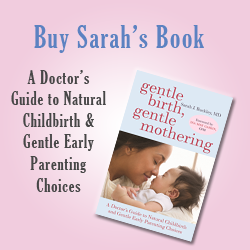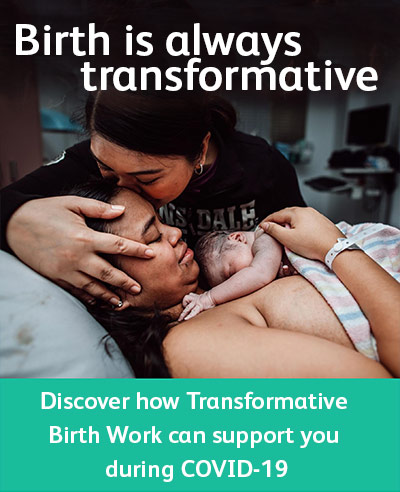@ Dr Sarah J. Buckley 2010 www.sarahbuckley.com
Excerpted from Gentle Birth, Gentle Mothering: A Doctor’s Guide to Natural Childbirth and Gentle Early Parenting Choices (Sarah J Buckley, Celestial Arts, 2009).
Whether your baby sleeps in a nearby cot, bassinet, crib or ‘side car’, or shares your bed – there are some general principles that will make your baby’s sleep as safe as possible. These apply to all babies under one.
1. Put your baby on their back to sleep
Babies are more at risk of sudden infant death syndrome (SIDS) when they sleep prone; that is, face down. A baby in the prone position can’t get rid of body heat as efficiently, and can’t kick off excess bedding. Both factors can contribute to overheating, a risk factor for SIDS. ‘Back to sleep’ campaigns in many countries have reduced the number of babies dying of SIDS by up to 70 percent.
If you are breastfeeding and bed-sharing, your baby may spend time in the side position during and following nursing. Although this position is recognized as a risk factor for SIDS, we do not know if this also applies to breastfeeding, bed-sharing babies, who are much less likely to roll into the prone position (see page 257 in Gentle Birth, Gentle Mothering). It may be safer to turn your baby onto his or her back
2. Keep your baby’s head uncovered during sleep
Babies are safest without soft bedding items around them. This includes pillows (no child under one needs a pillow), quilts/doonas/duvets (blankets are safer), crib or cot bumpers (not recommended) and soft toys, all of which can end up over the baby’s head. Sheets need to be tucked in firmly, or fitted snugly so that they can’t come loose. Loose bedding can cover and suffocate.
Babies in a cot are safest tucked in firmly with their feet at the bottom of the cot. Co-sleeping babies also need to be kept from slipping under the bedding.
Waterbeds and beanbags are not safe places for sleeping babies, who can slip into a soft pocket of bedding. Firm mattresses are recommended wherever your baby sleeps. If one parent is very heavy, use a very firm mattress to ensure that the baby cannot roll into a depression in the mattress.. If bed sharing with another adult as well as your baby, it is probably safer to sleep your baby on the outside edge, rather than between two adults
3. Avoid entrapment hazards
A small baby can become wedged in a gap and suffocate. Å hazardous gap may be formed
- between a mattress and the side of a crib (cot)Australian standards allow a gap no greater than one inch (2.5cm or two finger widths)
- between the mattress of an adult bed and the wall or adjoining furniture
- between the mattress and headboard, footboard or railings
- between a mattress and bed guard rail (+Bed guard rails are not recommended for children under one, but I highly recommend the simple ‘Humanity Family Bed co-sleeper’ for a safe guard system- see references.)
An adult mattress for bed sharing may be safer on the floor well away from walls, but you should always ensure that a baby who rolls off is safe from entrapment and injury.
4. Avoid strangulation hazards
Check your baby’s sleep environment for long strings or ties. This also applies to mobiles hung over cribs (cots). It is recommended that bed sharing adults prevent entanglement or strangulation by tying up their hair if it is longer than waist-length. Again, crib (cot) bumpers (with or without ties) are not recommended.
5. Dress your baby appropriately for the room temperature
It is important to avoid both over- and under-heating.
In winter, your baby does not need both very warm clothing and very warm bedding. A solitary sleeping baby can be dressed in a ‘blanket sleeper’ or securely tucked into bedding appropriate to the season.
A bed-sharing baby will be kept warm by body contact and also does not need more than one layer of clothing. A cotton singlet or T-shirt, long or short sleeved according to the climate, and a diaper(nappy) is usually sufficient. Natural fibre (cotton, wool, hemp, silk) clothing and bedding is recommended.
Also ensure that the room is not over-heated or too cool. Consider whether the heating, bedding and clothing would add up to a comfortable sleeping temperature for you.
6. Keep your baby smoke and drug free
This means avoiding smoking during pregnancy as well as after birth. Studies show that babies born to mothers who smoked in pregnancy have an increased risk of SIDS, and it is recommended that these mothers do not bed-share with their babies.
After birth, keep cigarette smoke away from your baby at all times. For mothers who cannot quit, cutting down will reduce the risk to some extent. Babies are also generally safer from SIDS if the father does not smoke, and bed-sharing with a smoking father may increase the risk of SIDS. If either parent smokes, they can still safely sleep their baby on a separate surface close by.
It is also important that bed sharing parents are not under the influence of drugs or alcohol, including prescription tranquillizers and sleeping pills. . These can make them sleep too deeply to monitor their baby’s safety overnight.
7. Do not leave your baby to sleep alone in an adult bed
Adult beds have entrapment hazards, as noted, as well as the danger of suffocation from soft bedding. Your baby is safer sleeping alone in a crib (cot) or in a safe place on a mattress on the floor, away from pets. It is also unsafe to sleep a baby next to a sibling or young child who might roll onto them.
Cultures with low SIDS rates incorporate baby sleep-time into family life, for example having babies sleep in a family room, rather than isolating them at sleep-time, which may increase SIDS vulnerability. Most babies will sleep happily with a large amount of noise and activity around them. (Consider how noisy and active it was in your belly!)
8. Ensure that older babies in cots cannot climb or fall out
Once your baby can sit, lower the mattress if adjustable. Once the baby can stand, put the mattress at the lowest level and ensure that there are no aids to escape – that is, items the baby can stand on or pull down into the crib (cot).
A child who is taller than 35 inches (90cm) has outgrown the crib (cot).
9. Do not put your baby to sleep on a sofa or chair
Not only is this dangerous in terms of falling off, but babies can become entrapped in the gaps of a sofa or chair, which are much more hazardous than a bed, crib or cot.
Also check your baby’s carriage or stroller and do not leave your baby sleeping there without adult supervision. Babies can become entrapped or suffocated while sleeping in these, which are not designed for unsupervised sleep.
10. Breastfeed your baby
In some studies, breastfeeding has been shown to give added protection against SIDS, which may be greater with more frequent breastfeeding.. Breastfed babies arouse more readily from deep sleep, which may help protect from SIDS.
Breastfeeding and bed sharing are also an ideal combination, because bed sharing babies nurse more frequently but with less effort on the mother’s part. This extra breastfeeding provides more nourishment for the baby and benefits the mother by delaying the return of her fertility, acting as a natural family spacing.
If you are formula feeding, bed sharing may be less safe: it may be preferable to provide a separate, close-by sleeping surface for your baby
References
Information for this article is drawn from the following sources:
Sleeping with your baby – the world’s top scientists speak out. Mothering no 114, Sept–Oct 2002, especially the following articles.
Safe Environment Safety Checklist – Patricia Donohue-Carey,pp 44–7
The New Zealand Experience – how smoking affects SIDS rates. Taylor B, Baddock S, Mitchell E, Ford R, Tipene-Leach D, Galland B. pp 62–7
Breastfeeding and Bedsharing – Still Useful (and Important) after All these Years. McKenna J. pp 28–37
This issue is available as a digital reprint at http://shop.mothering.com/product-p/digreprint-cosleep.htm
Bed-sharing information at UNICEF/UK Baby Friendly Hospital Initiative http://www.babyfriendly.org.uk/
Humanity Family Bed Co-sleeper http://www.humanityorganics.com/humanity-family-sleeper.html
Dr James McKenna’s research http://www.nd.edu/~jmckenn1/lab/safe.html

